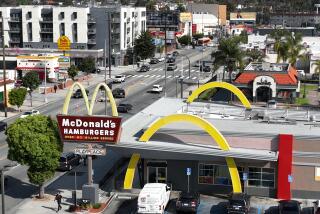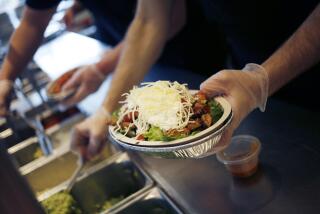Eyes will pop
- Share via
LAS VEGAS -- Global warming has had a strange effect on Hollywood, such as stars trading in their sports cars for hybrids and Al Gore hoisting an Oscar. But its latest impact may also be its corniest.
As a consequence of the booming demand for alternative fuels -- with farmers replanting acres of popcorn with more profitable crops that can be converted into ethanol and other biofuels -- the sellers of the nation’s favorite movie snack say the salty tub will soon take a bigger bite out of your wallet when you’re at the multiplex.
“The consumer will probably see an increase in popcorn prices pretty soon,” said Carlton Smith, the chairman of Iowa’s Jolly Time popcorn brand.
While the price hike will likely be modest, perhaps no more than 15 cents a serving, the rise is inevitable and necessary, according to the popcorn providers and theater owners gathered here for ShoWest, the annual convention of the National Assn. of Theater Owners, which ended Thursday.
Movie audiences have long complained that pricey concessions -- along with chatty moviegoers, in-theater advertising and the crummy quality of many new releases -- have made watching movies at home often more attractive than going to theaters. While box-office grosses are rising because of higher ticket prices, with 2007’s take totaling $9.6 billion, annual admissions are essentially flat, hovering around 1.4 billion tickets sold each year.
But if audiences worry that movie snacks are too expensive, they need to know those $5 buckets of popcorn ($4.75 for a large at Southern California’s Laemmle theaters, but that comes with free refills) is what keeps the average national admission price around $7.
“If we didn’t charge as much for concessions as we did, the tickets to the movies would cost $20,” said Mike Campbell, chairman and chief executive of Regal Entertainment Group, the nation’s largest theater chain with 6,300 screens.
Concession sales are a theater’s lifeblood, accounting for as much as 45% of profits at the nation’s largest chains. Popcorn offers one of the biggest returns on investment for exhibitors, because the unpopped kernels used to make an entire bucket of popcorn cost just a few pennies.
But the price that the mostly Midwestern farmers are charging for raw popcorn has doubled in the last two years, and the wholesale fees popcorn providers are charging theaters is starting to climb almost as fast. In addition to affecting the cost of movie-theater popcorn, fans of microwave versions may notice a markup as well.
A year ago, a theater operator buying a 35-pound bag of Orville Redenbacher’s Gourmet Popping Corn paid $7.50. At the 2008 ShoWest convention, it has climbed to $10.17, said Mike Donahoe, a national sales manager for Minnesota’s ConAgra Foods, the country’s leading theater popcorn manufacturer. “And I don’t see it getting any better.”
Norm Krug, the chief executive of Nebraska’s Preferred Popcorn, spent almost as much time at the theater owners convention calling farmers as he did trying to drum up business on the convention floor.
“It will be a challenge to get the acres planted with popcorn,” Krug said, noting that when growers start sowing their fields in early May they may opt for potentially more lucrative alternative fuel crops such as seed corn and soybeans. “I am making two to three calls a day to the farmers while I am here, telling them I will pay whatever it takes to get popcorn planted.”
Despite the country’s voracious appetite for popcorn -- Americans consume 4 billion gallons annually, or about 13 gallons a person, according to the Popcorn Board -- it is hardly one of the nation’s biggest crops.
Krug said about 240,000 American acres are planted with popcorn, while 77 million acres are planted with seed corn, which is generally a less fickle variety and consequently easier to grow.
ConAgra’s Donahoe said that, while only 2% of seed corn was destined to be turned into ethanol a year ago, about 20% of the crop is slated to be sold to make alternative fuel that is mixed with gasoline. American ethanol production surged to about 6.5 billion gallons last year, up from 4.9 billion gallons in 2006, according to the Renewable Fuels Assn.
With the demand for seed corn rising, so too has its price, which in turn drives up the price for popcorn. Two years ago, a farmer charged about $10 for 100 pounds of popcorn. Today it’s about $20. “The farmers are in the driver’s seat, definitely,” said Jolly Time’s Smith. Since corn is a main ingredient in livestock feed, its skyrocketing price has also led to higher costs for meat, poultry and eggs.
But it’s not just the higher raw popcorn costs that will drive up prices for the snack at the multiplex. Some farmers are taking their cooking oil crops -- soybeans, coconut, palm -- and sending them to alternative fuel manufacturers too.
“So even in the Philippines and Malaysia, they are looking to turn coconut and palm oil into biodiesel fuels,” said Mike Bates, the director of concessions for Louisiana’s Ventura Foods. Bates said the price for the popcorn cooking oils he sells to theater owners has doubled in the last year, from 45 cents a pound to 90 cents.
For years, popcorn manufacturers have offset their rising costs by developing new hybrids that expand more. A few years back, a typical popcorn kernel expanded about 35% in volume when it was cooked. That figure has reached nearly 50% today, but the expansion rate can’t really get much higher, as movie audiences would essentially be eating little more than salty air.
Thanks to holding a massive inventory of uncooked popcorn, the Regal theater chain won’t have to raise its popcorn price immediately but probably will have to eventually. “The prices will have to go up a bit,” said Campbell.
--
More to Read
The biggest entertainment stories
Get our big stories about Hollywood, film, television, music, arts, culture and more right in your inbox as soon as they publish.
You may occasionally receive promotional content from the Los Angeles Times.











